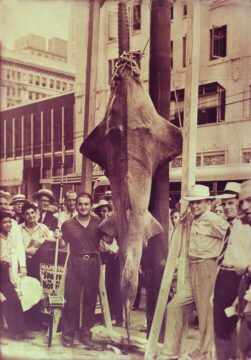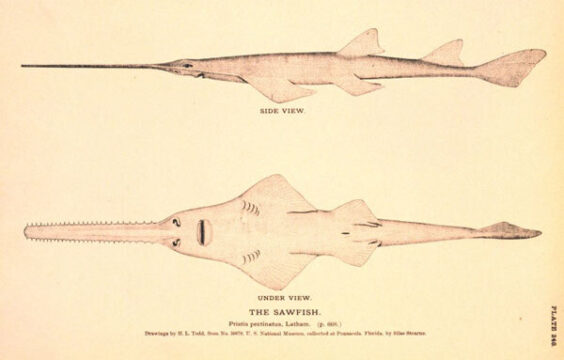On July 6, 1888, Colonel Sinclair stood on the Pagoda platform (located near the Beach Hotel between 23rd and 25th Street) surrounded by a crowd of onlookers. Galvestonians had gotten wind of a “huge leviathan from the Gulf” that was to be brought in, and they wanted to see the spectacle first hand. The Colonel did not want to just capture the beast; he wanted to conquer it and put it on display. Onlookers saw a huge chalk outline complete with large teeth, and knew that something big was about to happen. A group of men waded into the water with ropes, careful to avoid the deadly head of the beast, and began to pull. They were suddenly met with a loud noise. To the Colonel’s great shock, his magnificent catch, a giant sawfish, was not only dead; its carcass had been picked clean by crabs. The sight was so traumatic he fell off the platform and into the Gulf.

Fish tales like these made great news stories and were fairly common many years ago. Sportsmen and professionals alike pulled in spectacular large game fish, but regretfully, such catches have become much less common. To help celebrate Earth Day and raise awareness of conservation efforts, the Rosenberg Library Museum displayed its collection of smalltooth sawfish (Pristis pectinata) rostra (singular: rostrum) donated by Julius Puccetti, by the estate of Dr. J.O. Dyer, and by Captain Fredrick Sexson, as the April 2013 Treasure of the Month.
Sawfish are in the same family of marine animals as sharks and rays called Elasmobranchii. They can grow to be eighteen-feet long and reach sexual maturity from anywhere between 10 and 33 years of age. Their most striking feature is their snout, called a “rostrum.” It has saw-like modified tooth structures called denticles (which are actually scales) on each side which help the sawfish hunt. The rostrum works like a metal detector as the sawfish hovers over the ocean floor looking for hidden food. It is also used as a digging tool to unearth buried crustaceans. Sawfish catch their food by waiting for a fish to swim by before slashing at it with the saw, usually stunning or injuring the prey. In addition to hunting, the rostrum is also the sawfish’s primary means of protection from predators. However, the rostrum has proven to also be a liability, as it is easily tangled in nets and has been coveted as a trophy by fishermen for many years. Sawfish liver oil has been used in folk medicine, and like shark fins, sawfish fins are considered a culinary delicacy by some.

Galveston was once a hotspot for sawfish. Galveston Daily Newsarticles from as early as the mid-1880s document numerous catches. In 1886 a fifteen-foot specimen was pulled from the Gulf and placed in a large tank near the Beach Hotel where visitors could pay ten cents to view the oddity. Sadly it lasted only about a week before it died. That year also saw a twenty-foot specimen pulled in by fishermen. The largest documented sawfish ever caught in Texas via hook and line (788 pounds) was landed by Gus Pangarakis of Houston in 1939 near San Luis Pass. Other large catches included a 700-pounder caught on the west end after it was injured by a ship in 1935, a 1000-pounder caught near High Island by a shrimp net in 1938, and a seventeen-foot long specimen caught in 1967 that was brought to Sea-Arama (where it lived less than a day).
Today smalltooth sawfish are found in tropical and sub-tropical areas around Africa, America, Australia, and the Caribbean. During the early 20th century, the species was common from New York all the way to Texas but is now found primarily in Florida. Sawfish can live in both fresh and salt water and often hunt in murky shallow water. This habitat is fraught with many dangers, primarily that of shrimping nets. Little is known about their reproductive habits, but it is estimated they that only mate once every two years and have an average litter of eight offspring. This, coupled with a long juvenile period, makes recovery efforts difficult. All species of sawfish are considered critically endangered, and the smalltooth is no longer found in this part of the Gulf of Mexico.
The National Marine Fisheries Service (NMFS) has conducted much research and developed a recovery plan to help bring sawfish populations to a self-sustaining level. Since there have been several cases of sawfish caught in trawls and nets, the NMFS has developed policies for safely handling, reporting, and releasing accidental catches. They also tag and conduct genetic tests on many specimens to help identify breeding and pupping habitats.
In 2009 the Texas Parks and Wildlife took samples of the rostra in the Rosenberg Library’s museum collection to help create genetic testing tools to support conservation efforts. By having a substantial database of DNA, officials can easily distinguish between the fins of sawfish and sharks, thus cracking down on the illegal fin trade. DNA testing can also give insights into how genetic variations have changed with the sharp decrease in the sawfish population.
